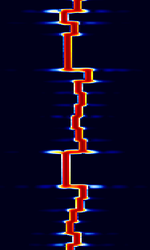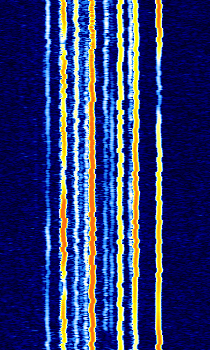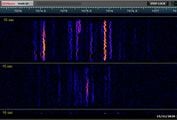FT8
FT8 ("Franke-Taylor design, 8-FSK modulation") is an extremely-weak-signal, digital, narrow bandwidth (50 HzHertz (Hz), unit of frequency, defined as one cycle per second (1 Hz).), QSO-only communication protocol used by amateur radio ("ham radio") operators. It is popular among amateur radio operators for its ability to send signals despite challenging propagation conditions, high noise environments, low power operations (QRPIn amateur radio, QRP operation refers to transmitting at reduced power while attempting to maximize one's effective range.), or even compromised antennas.
FT8 transmits and receives only the bare essentials needed to make an amateur radio contact (QSO): Exhange of callsigns, readability report, signal strength report, and "best regards" ("73"). Because only this information can be sent, FT8 is not a "conversation" mode. FT8 transmits this minimum of information in a semi-automated fashion on its own time frame. Therefore, FT8 is not a "keyboard-to-keyboard" (real-time chat) mode.
JS8 is a variant of FT8 which allows operators to send more information and converse with each other. JS8 was created to allow the basic principles of FT8 to be applied to sending actual messages (instead of just the bare minimum QSO information that FT8 limits operators with).
Both FT8 and JS8 are heavily dependent on an accurate computer clock, since the modes send/receive information in a recurring, automated, 15s transmit/receive cycle. Transmissions occur in 12.6s intervals (within the 15s transmit cycle window) until an entire message has completed transmitting. FT8 uses 8-GFSKGaussian Frequency-Shift Keying modulation, includes forward error correction (FECForward Error Correction), and has an effective data rate of 5 words per minute. FT8 transmissions can be decoded at S/N down to -21dB (very weak signal).
FT8 was developed by Joe Taylor (K1JT) and Steve Franke (K9AN). It is one of the modes included in the open-source, weak signal, ham radio software package, WSJT-X.
Samples[edit]
| Typical FT8 activity on amateur radio band (USBUpper Side Band Modulation (Radio, referring to reception and modulation mode)Universal Serial Bus (Computer, referring to USB Ports and cables), 3 kHzKiloHertz (kHz) 10^3 Hz BW) |
|---|
A Typical FT8 QSO[edit]
| A Typical FT8 QSO | |
|---|---|
| Characters Sent / Received | Interpretation |
| "CQ KI7PO DN06" | CQ call from radio operator "KI7PO" along with his Maidenhead grid square locator code. |
| "KI7PO IZ1M JN35" | Radio operator "IZ1M" replies with his callsign and grid square locator. |
| “IZ1M KI7PO -10” | KI7PO responds with a signal report
(in the form of a WSJT-X dBThe decibel (dB) is a logarithmic unit used to express the ratio of two values of a physical quantity, here the strength of a received signal. reading instead of in a more conventional, though more subjective, rstS reading) |
| “KI7PO IZ1M R-12” | IZ1M confirms signal report & replies with his own report |
| “IZ1M KI7PO RRR” | KI7PO tells IZ1M, "Reception Report Received"
(This can also be shortened to "RR73" indicating, "Report Received 73," which would be a completed QSO) |
| “KI7PO IZ1M 73” | IZ1M says "Best regards" ("73") |
| “IZ1M KI7PO 73” | KI7PO says "Best regards" ("73")
(not used if KI7PO's third transmission was "RR73") |
Operators will transmit one message within a 15 second time-frame, then wait for another 15 seconds to receive any incoming replies (then transmit again, then wait again, in a cycle that exchanges messages until the conversation is completed). Therefore, the complete exchange (QSO) above would take about 105 seconds. (references)
Frequencies[edit]
"By default the [WSJT-X Software's] Working Frequencies table contains a list of frequencies conventionally used for modes FT8, JT4, JT9, JT65, MSK144, WSPR, and Echo. Conventions may change with time or by user preference; you can modify the frequency table as desired." FT8 is designed as an HFHigh Frequency (3-30 MHz) mode, but (as with any amateur radio mode) can also be used on VHFVery High Frequency (30-300 MHz)/UHFUltra High Frequency (300-3000 MHz) if desired.
| Common Frequencies for FT8 & JS8Call | |||
|---|---|---|---|
| Band | Frequencies (MHzMegaHertz (MHz) 10^6 Hz) | IARU Region | |
| FT8 | JS8Call | ||
| 160m | 1.840 | 1.842 | All |
| 80m | 3.573 | 3.578 | All |
| 60m | 5.357 | ||
| 40m | 7.056 | Region 1 | |
| 7.071 | |||
| 7.074 | 7.078 | All | |
| 30m | 10.132 | 10.130 | Region 1 |
| 10.133 | |||
| 10.136 | All | ||
| 20m | 14.071 | ||
| 14.074 | 14.078 | All | |
| 14.090 | Region 1 | ||
| 17m | 18.100 | 18.104 | All |
| 15m | 21.074 | 21.078 | All |
| 21.091 | |||
| 12m | 24.915 | 24.922 | All |
| 10m | 28.074 | 28.078 | All |
| 6m | 50.310 | ||
| 50.313 | 50.318 | All | |
| 50.323 | 50.328 | All / Intercontinental DX | |
| 4m | 70.100 | Region 1 | |
| 4m | 70.154 | (Countries without access to 70.100) | |
| 2m | 144.174 | All | |
| 1.25m | 222.065 | ||
| 70cm | 432.065 | ||
| 70cm | 432.174 | ||
| 23cm | 1,296.174 | ||
Grayed-out cells are commonly-used frequencies which are not included in the default program settings of JS8Call or WSJT-X (FT8). Frequencies for JS8Call and FT8 are adjustable by the user.
(Sources: WSJT-X 2.1.0 Program default settings, DXZone, WSJT-X Documentation, JS8Call Documentation)
Controversy[edit]
Since FT8 automatically transmits and receives only the bare minimum of information necessary to complete what officially counts as an amateur radio contact (QSO), FT8 has been criticized by some amateur radio enthusiasts as a means for radio amateurs to 'cheat' their way to victory in certain contests and award categories. Other amateur radio operators herald the mode as a boon to the hobby of amateur radio during times when the solar cycle is at a minimum and when radio propagation conditions are poor.
Decoding Software[edit]
- Hobby Level Software
- Professional Software




